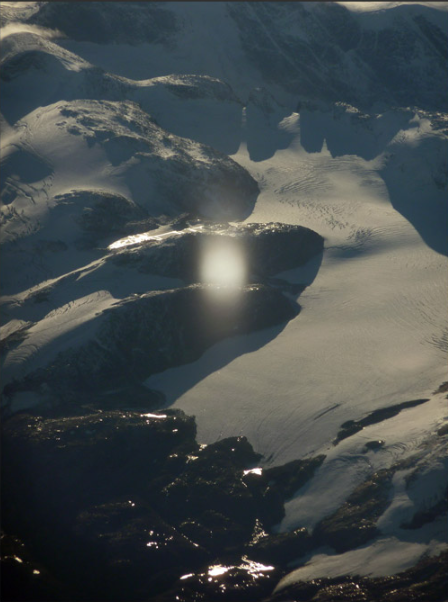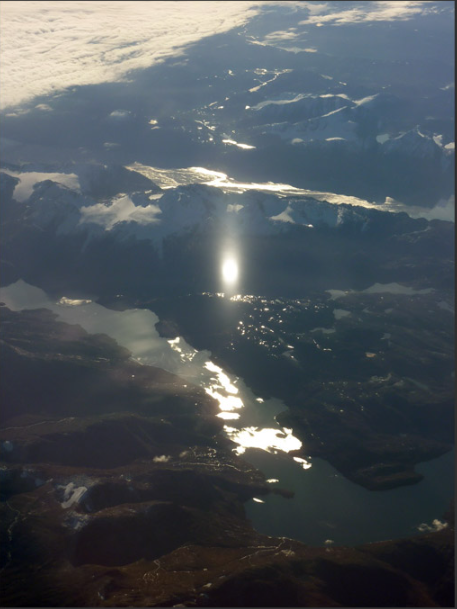OPOD - Greenland subsun
OPOD - Greenland Subsun: A Breathtaking Atmospheric Phenomenon
Have you ever witnessed the mesmerizing beauty of a subsun? This rare atmospheric optics phenomenon occurs when millions of plate-shaped ice crystals in a thin lower cloud layer reflect sunlight, creating a direct reflection of the sun itself. Recently, Stefan Kuna had the incredible opportunity to capture an image of the Greenland subsun as he flew over Southwest Greenland. The subsun appeared to follow the aircraft, providing a captivating display against the backdrop of glaciers flowing from the immense Greenland ice cap, which is second in size only to Antarctica.
The Greenland subsun is a captivating spectacle that demands our attention and appreciation. Let's delve deeper into this extraordinary phenomenon and explore the intricacies that make it so awe-inspiring:
The Formation of the Subsun
The subsun is formed by the interaction of sunlight with countless plate-shaped ice crystals suspended in a thin layer of clouds. As sunlight passes through these ice crystals, it undergoes refraction and reflection, resulting in a direct reflection of the sun's rays. This reflection appears as a bright spot beneath the actual sun, creating the illusion of multiple suns in the sky.
Greenland: A Perfect Setting for the Subsun
Greenland provides an ideal setting for observing the subsun due to its vast ice-covered landscapes and frequent cloud cover. The Greenland ice cap, an immense sheet of ice covering much of the island, reaches thicknesses of up to 3 kilometers (1.8 miles) in certain areas. As the sun's rays penetrate through the clouds, they encounter the abundant ice crystals present in the lower cloud layer, giving rise to the mesmerizing subsun phenomenon.
The Magnificent Dance of Light
As Stefan Kuna's aircraft soared above Southwest Greenland, he witnessed a truly breathtaking dance of light. The subsun seemed to accompany the aircraft, its ethereal glow shimmering against the backdrop of glaciers flowing from the Greenland ice cap. This celestial partner mirrored the aircraft's movements, creating an otherworldly connection between the observer and the heavens above.
Capturing the Subsun: A Photographer's Delight
Photographing the subsun is a challenging task that requires both skill and luck. The ever-changing atmospheric conditions and fleeting nature of this phenomenon make it a rare sight to behold. However, for those fortunate enough to capture it on camera, the resulting images are nothing short of spectacular. Stefan Kuna's photograph of the Greenland subsun serves as a testament to the beauty and wonder of this atmospheric spectacle.
Exploring Atmospheric Optics
The Greenland subsun is just one example of the countless wonders found within the realm of atmospheric optics. From rainbows and halos to mirages and iridescence, our atmosphere is a canvas for an array of captivating optical phenomena. These natural wonders continue to fascinate scientists, photographers, and sky gazers alike, providing endless opportunities for exploration and discovery.
Appreciating Nature's Artistry
The subsun reminds us of the incredible artistry found in nature. It serves as a reminder that even in our modern world, there are still mysteries and marvels waiting to be discovered. By taking the time to appreciate these fleeting moments of beauty, we gain a deeper understanding of our world and our place within it.
In conclusion, the Greenland subsun is a truly remarkable atmospheric optics phenomenon that enchants and captivates all who have the privilege of witnessing it. As we continue to explore and uncover the secrets of our atmosphere, let us never forget to pause and appreciate the breathtaking displays of nature that unfold above us.

Greenland Subsun ~ Imaged by Stefan Kuna. ©Stefan Kuna, shown with permission.
The subsun is a direct reflection of the sun from millions of plate shaped ice crystals in a thin lower cloud layer.
It followed the aircraft as it passed over SW Greenland . Below are glaciers flowing from the Greenland ice cap. The cap is second only to Antarctica in size and in places is up to 3km (1.8 mile) thick.



Note: this article has been automatically converted from the old site and may not appear as intended. You can find the original article here.
Reference Atmospheric Optics
If you use any of the definitions, information, or data presented on Atmospheric Optics, please copy the link or reference below to properly credit us as the reference source. Thank you!
-
<a href="https://atoptics.co.uk/blog/opod-greenland-subsun/">OPOD - Greenland subsun</a>
-
"OPOD - Greenland subsun". Atmospheric Optics. Accessed on November 15, 2024. https://atoptics.co.uk/blog/opod-greenland-subsun/.
-
"OPOD - Greenland subsun". Atmospheric Optics, https://atoptics.co.uk/blog/opod-greenland-subsun/. Accessed 15 November, 2024
-
OPOD - Greenland subsun. Atmospheric Optics. Retrieved from https://atoptics.co.uk/blog/opod-greenland-subsun/.